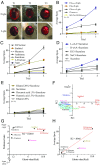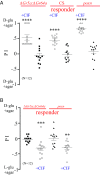Communicating the nutritional value of sugar in Drosophila
- PMID: 29507251
- PMCID: PMC5866586
- DOI: 10.1073/pnas.1719827115
Communicating the nutritional value of sugar in Drosophila
Abstract
Sweet-insensitive Drosophila mutants are unable to readily identify sugar. In presence of wild-type (WT) flies, however, these mutant flies demonstrated a marked increase in their preference for nutritive sugar. Real-time recordings of starved WT flies revealed that these flies discharge a drop from their gut end after consuming nutritive sugars, but not nonnutritive sugars. We proposed that the drop may contain a molecule(s) named calorie-induced secreted factor (CIF), which serves as a signal to inform other flies about its nutritional value. Consistent with this, we observed a robust preference of flies for nutritive sugar containing CIF over nutritive sugar without CIF. Feeding appears to be a prerequisite for the release of CIF, given that fed flies did not produce it. Additionally, correlation analyses and pharmacological approaches suggest that the nutritional value, rather than the taste, of the consumed sugar correlates strongly with the amount (or intensity) of the released CIF. We observed that the release of this attractant signal requires the consumption of macronutrients, specifically nutritive sugars and l-enantiomer essential amino acids (l-eAAs), but it is negligibly released when flies are fed nonnutritive sugars, unnatural d-enantiomer essential amino acids (d-eAAs), fatty acids, alcohol, or salts. Finally, CIF (i) is not detected by the olfactory system, (ii) is not influenced by the sex of the fly, and (iii) is not limited to one species of Drosophila.
Keywords: CIF; aggregation pheromone; communication; nutritive sugar; sweet-insensitive mutant.
Conflict of interest statement
The authors declare no conflict of interest.
Figures







Similar articles
-
Pharyngeal sense organs drive robust sugar consumption in Drosophila.Nat Commun. 2015 Mar 25;6:6667. doi: 10.1038/ncomms7667. Nat Commun. 2015. PMID: 25807033 Free PMC article.
-
Sweetness induces sleep through gustatory signalling independent of nutritional value in a starved fruit fly.Sci Rep. 2017 Oct 30;7(1):14355. doi: 10.1038/s41598-017-14608-1. Sci Rep. 2017. PMID: 29084998 Free PMC article.
-
Effect of non-nutritive sugars to decrease the survivorship of spotted wing drosophila, Drosophila suzukii.J Insect Physiol. 2017 May;99:86-94. doi: 10.1016/j.jinsphys.2017.04.001. Epub 2017 Apr 5. J Insect Physiol. 2017. PMID: 28390875
-
Taste and pheromone perception in mammals and flies.Genome Biol. 2003;4(7):220. doi: 10.1186/gb-2003-4-7-220. Epub 2003 Jun 30. Genome Biol. 2003. PMID: 12844351 Free PMC article. Review.
-
Taste and pheromone perception in the fruit fly Drosophila melanogaster.Pflugers Arch. 2007 Aug;454(5):735-47. doi: 10.1007/s00424-007-0246-y. Epub 2007 May 1. Pflugers Arch. 2007. PMID: 17473934 Review.
Cited by
-
Preference and detrimental effects of high fat, sugar, and salt diet in wild-caught Drosophila simulans are reversed by flight exercise.FASEB Bioadv. 2020 Dec 4;3(1):49-64. doi: 10.1096/fba.2020-00079. eCollection 2021 Jan. FASEB Bioadv. 2020. PMID: 33490883 Free PMC article.
-
Anatomy and Physiology of the Digestive Tract of Drosophila melanogaster.Genetics. 2018 Oct;210(2):357-396. doi: 10.1534/genetics.118.300224. Genetics. 2018. PMID: 30287514 Free PMC article. Review.
-
How Sugar Quality and Concentration Influence Oviposition Preference in Drosophila Melanogaster.J Chem Ecol. 2025 Jun 20;51(4):67. doi: 10.1007/s10886-025-01620-3. J Chem Ecol. 2025. PMID: 40540140 Free PMC article.
-
Artificial sweeteners differentially activate sweet and bitter gustatory neurons in Drosophila.Sci Rep. 2025 Jul 1;15(1):20785. doi: 10.1038/s41598-025-08467-4. Sci Rep. 2025. PMID: 40594804 Free PMC article.
-
Using Pox-Neuro (Poxn) Mutants in Drosophila Gustation Research: A Double-Edged Sword.Front Cell Neurosci. 2018 Oct 24;12:382. doi: 10.3389/fncel.2018.00382. eCollection 2018. Front Cell Neurosci. 2018. PMID: 30405359 Free PMC article. Review.
References
-
- Caccamise D, Reed L, Stouffer P. Roosting behavior and group territoriality in American crows. Auk. 1997;114:628–637.
-
- Seeley TD, Visscher PK, Passino KM. Group decision making in honey bee swarms. Am Sci. 2006;94:220–229.
-
- Riley JR, Greggers U, Smith AD, Reynolds DR, Menzel R. The flight paths of honeybees recruited by the waggle dance. Nature. 2005;435:205–207. - PubMed
-
- Wilson EO. Chemical communication among workers of the fire ant Solenopsis saevissima (Fr. Smith) 3. The experimental induction of social responses. Anim Behav. 1962;10:159–164.
-
- Bartelt RJ, Schaner AM, Jackson LL. cis-Vaccenyl acetate as an aggregation pheromone in Drosophila melanogaster. J Chem Ecol. 1985;11:1747–1756. - PubMed
Publication types
MeSH terms
Substances
Grants and funding
LinkOut - more resources
Full Text Sources
Other Literature Sources
Molecular Biology Databases

